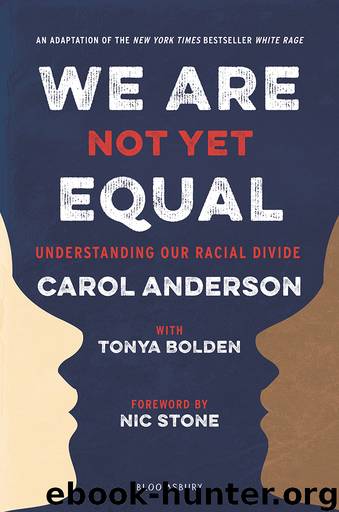We Are Not Yet Equal: Understanding Our Racial Divide by Carol Anderson & Tonya Bolden

Author:Carol Anderson & Tonya Bolden
Language: eng
Format: epub
ISBN: 9781547600786
Publisher: Bloomsbury YA
Published: 2018-09-10T23:00:00+00:00
While McCulloch saw the need to protect the ballot box, Attorney General John Mitchell, who had served as director of Nixon’s 1968 presidential run, announced that the Department of Justice, which he viewed as “an institution for law enforcement, not social improvement,” opposed the VRA’s renewal.
Why?
Mitchell claimed that it targeted, and therefore discriminated against, the South.
This upside-down framing of the VRA (and the sense that it was somehow not about the law but social engineering) purposely whitewashed the brutal electoral history of Jim Crow. It transformed ruthless perpetrators into innocent victims.
In addition to engaging in electoral shenanigans, more than a few Southern states had sanctioned or even fomented widespread terrorism against voting rights activists.
On September 25, 1961, Herbert Lee, who was helping to register black people in Amite County, was ambushed and executed by a Mississippi legislator, E. H. Hurt. A few years later, another black man, World War II veteran Louis Allen, a witness to Lee’s murder, was treated to a shotgun blast that blew off his face. Both executions sent a signal that the death sentence awaited blacks who had the audacity to vote and help others do likewise.
And there were the bullet-riddled corpses of James Chaney (black), Andrew Goodman (white), and Michael Schwerner (white), bodies unearthed on August 4, 1964, after weeks spent beneath tons of dirt in Neshoba County, Mississippi. Their murders had served as a warning that those advocating the right to vote were, as one local woman scoffed, “just looking for trouble.”
At a time when less than 1 percent of black people in Selma, Alabama, were registered to vote, there was the televised fury police officers unleashed on peaceful protesters—tear-gassed, whipped, trampled by horse-bound troopers—as these people tried to symbolically carry to the state capital of Montgomery the casket of slain black voting rights activist Jimmie Lee Jackson. Jackson had been killed by law enforcement on February 26, 1965.
The horror of that attempt to cross the Edmund Pettus bridge on that Sunday, March 7, 1965—Bloody Sunday—was punctuated two days later by the bludgeoning of white Unitarian minister Reverend James Reeb. He had come to Selma from Boston in support of voting rights. The reverend died of his wounds on March 11.
These are just a few of the atrocities, the crimes against humanity, that had compelled sane people to say, Yes! A muscular Voting Rights Act is imperative.
But for only five years?
Despite Attorney General Mitchell’s insinuation, the VRA was neither capricious nor punitive. It was, as the Department of Justice noted, “targeted at those areas of the country where Congress believed the potential for discrimination to be the greatest.”
In 1966, in South Carolina v. Katzenbach, the US Supreme Court, in an 8–1 decision, affirmed the need for federal oversight, ruling that: “Congress had found that case-by-case litigation [based on the 1957 Civil Rights Act] was inadequate to combat wide-spread and persistent discrimination in voting, because of the inordinate amount of time and energy required to overcome the obstructionist tactics invariably encountered in these lawsuits. After
Download
This site does not store any files on its server. We only index and link to content provided by other sites. Please contact the content providers to delete copyright contents if any and email us, we'll remove relevant links or contents immediately.
Matar un ruiseñor by Harper Lee(440)
Gandhi by Kathleen Kudlinski(383)
The Missing by Michael Rosen(378)
Stella by Starlight(360)
We Are Not Yet Equal: Understanding Our Racial Divide by Carol Anderson & Tonya Bolden(360)
The Schoolmaster's Daughter by Jackie French(296)
The Invincible Summer of Juniper Jones by Daven McQueen(294)
This Book Is Anti-Racist: 20 Lessons on How to Wake Up, Take Action, and Do the Work by Tiffany Jewell(238)
